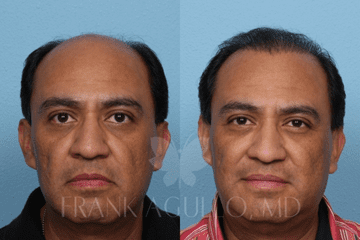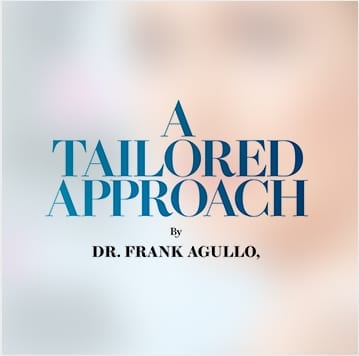What Are the Benefits of a Hair Transplant?
Improved Hairline
A receding hairline can significantly age your appearance. By restoring a youthful hairline with a natural shape, you can rejuvenate your appearance.
Thicker Brows
The eyebrows are often taken for granted, but without them, the face can look undefined. Restoring your eyebrows can give you a more balanced facial appearance and help convey your expressions.
Fuller Beard
Few things symbolize masculinity like a full beard. Hair transplantation can correct patchy or thin facial hair to finally give you the thick beard or scruff you desire.
Scar Coverage
Hair transplantation is a very effective way to cover up scars in the scalp, beard, or mustache area. It is especially effective for covering up scars resulting from facelifts or hairline lowering procedures.
Am I a Candidate for a Hair Transplant?
The ideal candidate for a hair transplant is someone who suffers from a receding hairline, has bald patches, or experiences thinning hair. Still, it is important to undergo a thorough evaluation so that Dr. Agullo may properly examine the areas of recession and other areas of the head, such as the forehead region and nape of the neck. Dr. Agullo can make a proper assessment of the health of the hair in your donor region and how easily incisions can be concealed with the length of your hair. To be a good candidate for a hair transplant, the existing hair must be of substantial quality in texture, color, and curl pattern.
Men in their early 20s can experience hair loss; however, they are encouraged to explore other options as their hairline will continue to mature long into their 40s and 50s. Most doctors will not be able to formulate a clear idea of how much hair loss will occur over several decades. Therefore, the ideal age for a hair transplant candidate is roughly between the ages of 30 and 65. If a potential candidate is past the age of 65, they may have too little hair to transplant.

What Does My Hair Transplant Include?
There are different options for executing a successful hair transplant. They include:
Follicular Unit Transplantation (FUT)
- A strip of tissue is removed from the donor site with a single, long incision
- The tissue is dissected into follicular units of one to four hairs
- The follicles are implanted one hair at a time in the recipient site via tiny incisions
- May leave some linear scarring at the donor site that can be concealed by the surrounding hair
- Most commonly used procedure for hair transplantation
- Best for larger transplants
Follicular Unit Extraction (FUE) With NeoGraft® 2.0
- The donor area is shaved
- The NeoGraft® 2.0 handheld device is used to make tiny, circular incisions around each hair follicle in the donor site
- The healthy hair follicles are suctioned out of the scalp with the NeoGraft® 2.0 handheld device
- Tiny incisions are made in the balding area to receive the harvested follicles
- Extremely low risk of scarring at the donor site
- No staples or sutures required
- Natural results for long or short hair
- Short recovery time
- This newer, more advanced version of the already exceptional NeoGraft® system allows for more precision and standardization

How Should I Prepare for My Hair Transplant?
Preparation is one of the primary elements of a successful hair transplant treatment. This can be done by following your surgeons’ instructions for what to do before your treatment. Some pre-operative instructions include:
- No smoking for at least two weeks before treatment, as smoking can inhibit blood flow and hinder healing
- No taking of blood-thinning medication and herbal supplements at least two weeks before your procedure
- Arranging for a ride home after surgery
- Arranging for at-home-assistance after surgery, if needed
At Agullo Plastic Surgery, tailored care begins with a full consultation to discuss the goals and options available.
What Are Your Concerns?
What Can I Expect for My Hair Transplant Recovery?
The recovery period for a hair transplant often varies based on several factors, such as the amount of hair transplanted from a donor region to the targeted region, the type of transplant method chosen, the placement of the transplanted hair, and other biological factors.
Typically, the healing time with the FUE NeoGraft® 2.0 hair transplant methods is generally five to seven days, and many patients are able to return to work the next day after their NeoGraft® 2.0 treatment. In contrast, the FUT hair transplant method has a longer recovery because of the elongated incision created in the donor site.
New hair growth will continue to develop over the following months.
Is My Hair Transplant Painful?
During your hair transplant, sedation will keep you comfortable and from feeling any pain or irritation. After treatment, discomfort can be managed and alleviated with over-the-counter pain medication.
Will My Hair Transplant Leave Scars?
The hair from your donor site will cover and camouflage any scars in existing balding areas as they continue to grow in. The resulting scar in the donor area will be hidden by the surrounding hair that existed before surgery.
When Will I See My Hair Transplant Results?
Dr. Agullo can masterfully create hair transplant results that are successful and permanent. Still, it will take time for your hair to grow in its newfound fullness and thickness. Typically, it takes three to four months for the hair follicles in the transplanted region to start growing. It will take six months to a year for the hair follicles to mature, develop, and take full form. Patients will be happy to discover that the biological standard for healthy hair growth in men is about a quarter of an inch to a half-inch growth per month.
What Are Some Frequently Asked Questions About Hair Transplant?
Intravenous (IV) sedation or local anesthesia in the donor and the recipient areas may be used for hair transplantation.
The length of the procedure will depend on the technique used, the area being treated, and its size. The procedure can vary from three to eight hours, but keep in mind that you will be relaxed and comfortable throughout the duration.
Hair transplantation can accentuate the fullness of your beard and restore the eyebrows for a more balanced and handsome facial appearance. With beards growing in fashion, there is no better opportunity to address patchy or uneven beard growth.
After treatment, the hairs transplanted into the treatment area will permanently grow, just like your natural hair.
Curly hair is known to give better coverage and denser-looking hair, due to its twists and turns. Generally, the graft used for straight and curly hair is the same. It is important to note that hair transplants for African American patients can be more challenging. There are specific considerations that surgeons must take to accommodate ethnic hair transplants. If you have hair of African or ethnic descent, it is important to discuss the common challenges with your surgeon.
Before hair loss treatment, it is important that women undergo a thorough examination of the type of hair loss they are experiencing. Generally, a hair transplant for women is different from a man’s hair transplant as the approach required for baldness in women is different than men. For men, hair loss begins at the temples and then the crown of the head. For women, female pattern baldness appears over the entire head and requires specialized techniques.
Unfortunately, hair follicles are only able to be transplanted to bald regions of the head. Some patients wish to have more fullness or thickness of hair in a certain area; however, if the patient’s head is already filled with hair follicles then the appearance of thickness is determined by the genetic background of your hair follicles. Patients may want to discuss different methods on how to make their full head of hair appear thicker, such as PRP hair treatment.
Interested in Hair Transplantation Options in El Paso, TX?
If you want to learn more about Dr. Agullo’s Hair Transplant, contact his office by calling (915) 590-7900. Dr. Agullo offers the FUT hair transplant and the FUE Neograft 2.0 hair transplant for patients in El Paso, Texas, and the greater El Paso area.






